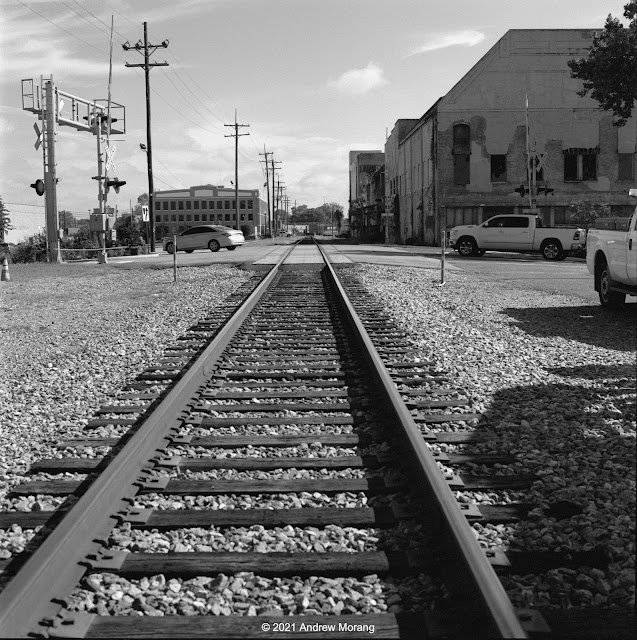Dear
Urban Decay readers, Happy New Year! Let us all hope that 2022 is a better year all around than 2021, which was pretty horrible for many people. At least the US stock market was happy, but that does not help millions of Americans. Maybe the pandemic will wane in the coming year and we can sort-of return to normal travel and mixing unsocial gatherings.
In the meantime, here are some photographs from my archives of Boston and Logan Airport.
_______________________________________________________________________________
 |
| Panorama of Boston and Logan Airport from Hilton Hotel, May, 1988. (4 Kodachrome frames from a Rollei 35S camera; click to enlarge and see details) |
I have flown in and out of Logan Airport too many times to remember, starting sometime in the 1950s.
The US Army built the original landing field, then named Boston Airport, in 1923 on tidal flats in East Boston. The fill at that time consisted of cinders, meaning coal clinkers. Many of the 1800s fills in and around Boston were a convenient way to dispose of clinkers. The term then used was reclamation, as if humans were "reclaiming" land from the sea. I remember during the 1973 oil crisis, some people suggested burning coal at home as a source of heat. My uncle, an old-timer, told me that was an absurd idea. Where would we take the ash and clinkers? He was right; it would be difficult to dispose of the coal waste for a city the size of Boston and its suburbs.
The Army operated Boston Airport until 1928, when they transferred it to the State of Massachusetts. As the years progressed, the state added more landfill, expanded runways, and built terminals. The field was renamed the General Edward Lawrence Logan International Airport (IATA: BOS). Today, Logan is a bustling transport hub, the 16th busiest airport in the USA, with many daily international flights.
 |
| Typical 1988 afternoon on the Southeast Expressway, waiting to transit to the Callahan Tunnel and to Logan Airport |
Logan is also a topographic confusion (OK, total mess) of twisting roads, buildings seemingly perched haphazardly all over the place, one-way streets, and choked traffic. It is often a nightmare getting in an out of Logan, especially by car. Decades ago, the State should have purchased another location for their main airport, a site inland that was not as constrained by water and had easier access.
The photograph above shows a typical afternoon on the old (now demolished) Southeast Expressway en route to Logan Airport. The Southeast Expressway was one of the grandiose 1950s projects to build high speed roadways through American cities, regardless of the environmental and societal cost. Opened in 1959, it was instantly hated because it partly cut off the Italian North End from the rest of the city. As you recall, these highways often cut through low-income neighborhoods (usually meaning African-American) as if the continuity of their neighborhoods was of no value. Also, those people usually did not have the access to high-power lawyers or political friends to argue their situation. But this sordid topic of corruption and giveaways to the construction industry is for a future blog article.


In 1988, I attended a training class in Cambridge and stayed a few nights at the Hilton Hotel at Logan Airport. Surprisingly, my room had an interesting view west towards downtown Boston (see the panorama) and overlooking some of the Logan hangars. Not bad for an airport hotel. This older building has been replaced by a modern and larger Hilton. In 1988, some operators still used propellor planes. Eastern Airlines was still operating, before being absorbed into PanAm and thereafter disappearing into bankruptcy oblivion.
In the photograph with the Eastern Airlines hangar, the long building across the water is the former Army Supply Base, also known as the Boston Quartermaster Terminal. In the late 1930, my father worked for the US Army Corps of Engineers in that building.
These are Kodachrome slides from a Rollei 35S compact camera with a 40mm ƒ/2.8 Sonnar lens. I scanned the slides with a Plustek 7600i scanner and created the panoramas with Photoshop CS6.
UPDATE. (Extra information in response to a comment left by Jim Grey below.)
Issue 1: The MBTA Blue Line stops at Airport (appropriate name). The problem with this stop is that it is too far from the terminals for most people to walk. Therefore, a surface bus runs on a loop to the terminals, car rental center, and Airport station. Decades ago, the bus cost 25 cents, cash only. I always wondered, a tourist steps off the plane from Paris or Lagos and he is supposed to have 25 cent coins ready to drop into the coin box? At least now, the bus no longer requires a fee.
Issue 2: In almost every European city that I have visited, plus Bangkok and Hong Kong, the train comes literally under the terminal. Go through passport control, pick up your bags, and take the escalator down to the train station. No need to fight snow or rain with your luggage. In 60 years, the MBTA has not been able to reroute the Blue line into a subterranean station the would be convenient for passengers? Seriously? And Boston likes to think it has a world-class airport?
Issue 3: In Airport station, you use a vending machine to buy a transit pass for one ride or various time periods. OK, that is easy. But a sign states that there is a reduced fare for senior citizens. However, this fare machine will only refill or validate an existing senior pass. You need to acquire the senior card downtown at another station. Seriously?

























































